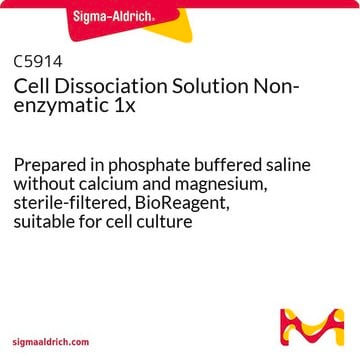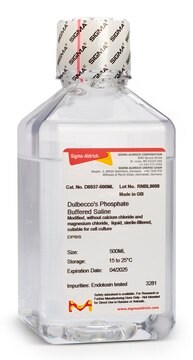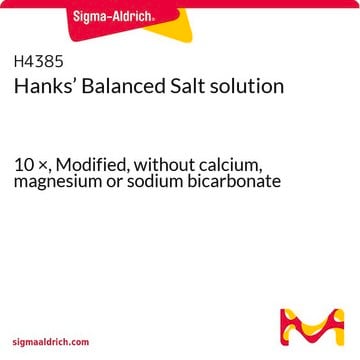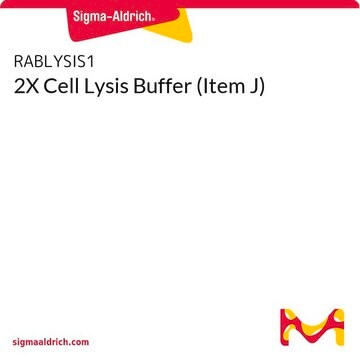This product contains EDTA as the major active component, which acts as a chelating agent for divalent cations to loosen cell–cell contacts but does not break down the extracellular matrix as trypsin does. Empirical testing is needed to determine if this approach is more effective. It is highly recommended to review the literature to determine if an EDTA-only dissociation method has been successfully used with the particular primary microglia preparation protocol.
C5789
Zellauflösungslösung, nicht enzymatisch 1x
Prepared in Hanks′ Balanced Salt Solution without calcium and magnesium, sterile-filtered, BioReagent, suitable for cell culture
Synonym(e):
Zelldissoziationsreagenz
Größe auswählen
About This Item
Empfohlene Produkte
Qualitätsniveau
Sterilität
sterile-filtered
Produktlinie
BioReagent
Form
solution
Konzentration
1 ×
Methode(n)
cell culture | mammalian: suitable
pH-Wert
6.5-7.5
Versandbedingung
wet ice
Lagertemp.
room temp
Suchen Sie nach ähnlichen Produkten? Aufrufen Leitfaden zum Produktvergleich
Allgemeine Beschreibung
Anwendung
Lagerklassenschlüssel
12 - Non Combustible Liquids
WGK
WGK 1
Hier finden Sie alle aktuellen Versionen:
Besitzen Sie dieses Produkt bereits?
In der Dokumentenbibliothek finden Sie die Dokumentation zu den Produkten, die Sie kürzlich erworben haben.
Kunden haben sich ebenfalls angesehen
-
Hi, I am working with primary microglia and it very tricky to dissociate. I usually dissociate them with 0.5% Trypsin for 7 min at 37˚C and still hard to collect them. May I know whether this reagent would be a better alternative? Thank you!
1 answer-
Helpful?
-
-
What is the concentration of EDTA in Cat#C5789? Thanks
1 answer-
The concentration of EDTA in this formulation is proprietary. Additional components include Sodium Citrate, Nitrilotriacetic Acid, and Glycerol in Hank's Balanced Salt solution. Should the concentration of EDTA be required, product E8008, EDTA 0.2% in DPBS, may be of interest. Both items are tested for cell dissociation. Please see the link below to review this product option:
https://www.sigmaaldrich.com/US/en/product/sigma/e8008Helpful?
-
Active Filters
Unser Team von Wissenschaftlern verfügt über Erfahrung in allen Forschungsbereichen einschließlich Life Science, Materialwissenschaften, chemischer Synthese, Chromatographie, Analytik und vielen mehr..
Setzen Sie sich mit dem technischen Dienst in Verbindung.












